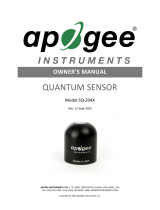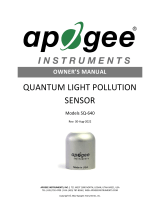Page is loading ...

8
6 3
Amplified
Quantum
Sensor
Owners Manual
Model: QSOA-E
QSOA-S
2.5 and 5.0 V options
Specifications
Calibration
Quantum sensors are calibrated for electric light or
sunlight. Average spectral errors associated with each
calibration are shown below.
435-792-4700
www.apogeeinstruments.com
Setup Instructions
Electric
Calibration
Sunlight
Calibration
Cool
White
Fluorescent
0% error 8% high
Metal Halide 0% error 8% high
High Pressure
Sodium 6% low 2% high
Sunlight 8% low 0% error
Red: positive (signal
from sensor)
Black: input power
Clear: ground (for sensor
signal and input power)
2.5 option 5.0 option
Power Supply 2.5 to 5.5 V 5.0 to 5.5 V
Conversion factor 1.0 µmol m-2 s-1
per mV
0.5 µmol m-2 s-1
per mV
Output (volts) 0.0 to 2.5 V 0.0 to 5.0 V
Full sunlight 2.0 V
(2,000 µmol m-2 s-1)
4.0 V
(2,000 µmol m-2 s-1)
Do not exceed 5 Volts in power supply.
QSOA-S (sunlight) QSOA-E (electric)
Calibration Natural sunlight Electric lamps (8% difference)
Absolute accuracy ± 5 % ± 5 %
Uniformity ± 3 % ± 3 %
Repeatability ± 1 % ± 1 %
Application Measuring Photosynthetic Photon Flux
2.5 V option Output 0 to 2.5 V (2.0 V = full sunlight 2,000 µmol m-2 s-1)
Input power 2.5 to 5.5 VDC
Sensitivity Custom calibrated to exactly 1.00 µmol m-2 s-1 / mV
5.0 V option Output 0 to 5 V (4.0 V = full sunlight 2,000 µmol m-2 s-1)
Input power 5 to 5.5 VDC
Sensitivity Custom calibrated to exactly 0.50 µmol m-2 s-1 / mV
Current draw 285 µA
Operating environment - 40 to 55 °C; 0 to 100% relative humidity. Designed
for continuous outdoor use. Can be submerged
under water (with or without mounting screw).
Materials Anodized aluminum with acrylic lens
Cable 3 meters of shielded, twisted-pair wire with
Santoprene casing, ending in pigtail leads.
Additional cable $1.95/meter.
Dimensions 2.4 cm diameter, 2.75 cm high
Mass 70 g (with 3 m lead wire)
Warranty 1 year against defects in materials and workmanship

2 7
4 5
Sensor Output
(4 V)
5.0 V
option
Full Sunlight
(2000 μmol m s)
Sensor Output
(2 V)
PPF =
=μm sμm s
2.5 V
option
μm s
μm s
Quantum Sensor Models
A quantum refers to the amount of energy carried
by a photon. Apogee quantum sensors approximate
the quantity of photons between 400 and 700
nanometers. Photosynthesis is largely driven by
the number of photons between these wavelengths,
so this radiation is called the Photosynthetic Photon
Flux (PPF) and is measured in μmol m-2 s-1.
Cosine response
Some of the radiation coming into a sensor at low angles is reflected, which
causes low readings. The convex optical disc is designed to capture radiation
at low angles and minimize cosine response errors. The cosine error for
typical applications is less than 2%.
Temperature response
The temperature response is less than 0.1% per degree Celsius. This
temperature error is not significant in most applications.
Long-term stability
Our research indicates that the average output increases approximately 1%
per year because of changes in the optical transparency of the diffusion disk.
We recommend returning the sensor for recalibration every 2 years.
Spectral Response
As shown in the graph below, quantum response by definition is from 400 to
700 nm, and gives equal emphasis to all photons in that range. The spectral
response of the Apogee sensor, as well as a typical plant response, are also
shown.
Amplified Quantum Sensors:
US Patent No. D519,860
Calibration
Use the designated conversion
factor (0.5 or 1.0 µmol m-2 s-1 per
mV) to convert the mV signal
from the sensor to photosynthetic
photon flux in µmol m-2 s-1 (multiply
the mV output by the conversion
factor to yield PPF in
µmol m-2 s-1).
The model, serial number, production date, and
calibration factor are located on the sensor cable.
Each sensor is equipped
with a mounting bolt.
Mount the sensor as
level as possible. Small
changes in level can cause
measurement errors. We
recommend using our
leveling plate (model LEV)
for the most accurate
measurements. The sensor
should be mounted with the
cable pointing toward the
nearest magnetic pole to
minimize azimuth error.
N
S
Model LEV
Bolt: 10-32x5/8
Mounting the QSOA-E and QSOA-S
Orientation
/





